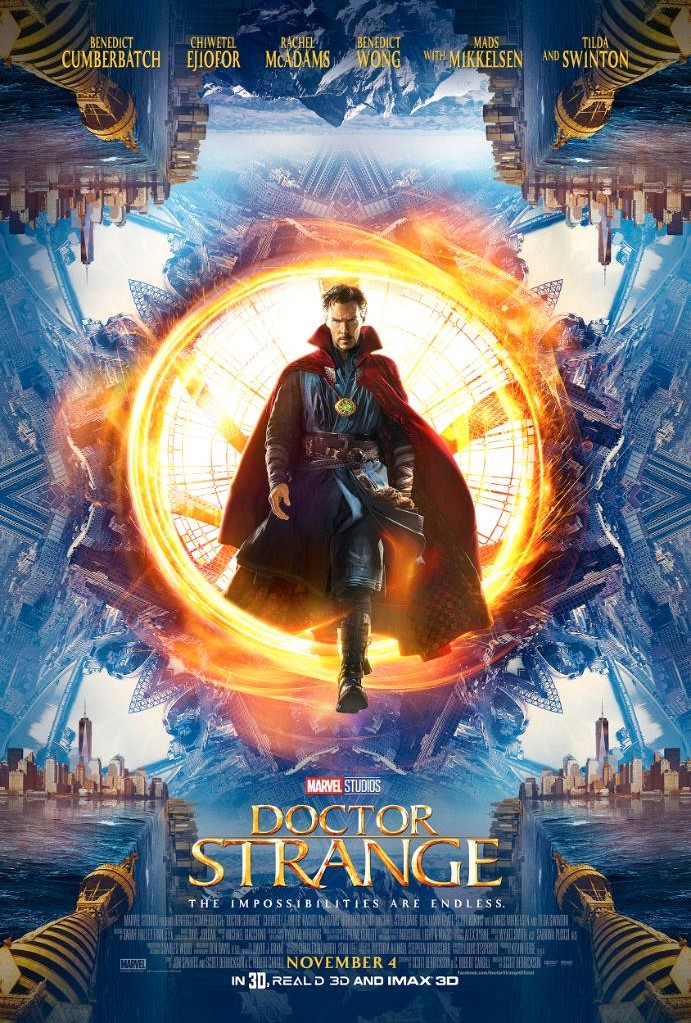Movie Breakdown: Doctor Strange (Noah)
Pre-Screening Stance:
It’s a Marvel movie starring Benedict Cumberbatch as a snooty doctor-turned-master-of-mysticism. Duh.
Post-Screening Ramble:
At this point in the 14-film cycle of the Marvel Cinematic Universe, you’re either in for the ride, or you’re trying to convince your friends that Suicide Squad is a good movie with a good story. That’s just how it is. Marvel Films, including this one, are molded by a committee of writers and producers to fit into a long plan, with each allowed a certain quota of artistic originality to separate them from the ever-growing pack. This makes sense to me because I’ve read Marvel Comic books for almost the entirety of my life, and well, that’s how comic books are. Each individual character is a part of a larger universe and as distinct as you want those characters to be, inevitably, their stories and their characters are servants of a grander picture. It’s just how it is. Doctor Strange is no different.
Benedict Cumberbatch (the latest in a long line of fucking fantastic actors who’ve slid into the Marvel sandbox) is Doctor Strange, a self-obsessed surgeon who must dive head-first into the world of mysticism when a car accident robs him of any functional use of his hands. He journeys to Nepal and meets The Ancient One (Tilda Swinton) and her posse of masters, including Mordo (Chiwetel Ejiofor), a rule-following magical badass who takes Strange under his wing. Strange learns some lessons, cracks some jokes, and faces off against a rebel magician, Kaecilius (Mads Mikkelsen) who’s fallen under the sway of a greater, of course, world-consuming villain. Though I won’t tell you (and don’t need to tell you) how it ends, if you’ve seen these movies before, you’ve probably got an idea.
So yeah, Doctor Strange under the direction of horror director Scott Derrickson, doesn’t sway terribly far from the Marvel Films canon we’ve seen before. This is a comic book origin story, it’s about taking a flaw in a powerful individual, overcoming that flaw, and then becoming the hero we always knew they were going to become. Cumberbatch’s Doctor Strange is like a less-rich Tony Stark, a man so confident in his own abilities, he doesn’t need to reach out for help. Until he does, which, conveniently, occurs near the end of the film, allowing him to overcome both his enemy(s) and his distancing personal issues. And Cumberbatch, with delightful cornball humor a plenty, dives into this role headfirst, running around like a British Tom Cruise, waving his arms frantically so CG-wizards can throw a few effects in – it’s great, and if the rest of Phase 4 flits around Doctor Strange, well, no one should be complaining. Beyond that, Derrickson takes the Marvel Universe into a new world of psychedelia. Strange is pulled through the “multiverse” on several occasions and the mind-warping 1986 Star Trek black hole effects are a delight to behold and are striking homages to the bizarre and wonderful world’s Doctor Strange’s creator Steve Ditko once drew into comic books. Also enjoyable, the clockwork turns of the Mirror Dimension, a convenient world directly touching ours that allows the masters to turn all of New York City (and beyond) into spiraling, twisting playgrounds pulled from the mind of MC Escher. It is, quite frankly, the most visually impressive of any Marvel film before it. Is it a challenging film that will rearrange the way you see cinema? No. Does it work as a new branch of the MCU, introducing a fantastic new addition to the world while slightly bumping the entirety of the over-arching story forward? Yes. And it does so with aplomb and vision and an ensemble of actors who throw themselves into what could be a truly silly film with just enough conviction to make it all work.
One Last Thought:
Dear 3D Glasses: fuck you. I spent a considerable amount of this movie removing my glasses so I could actually tell what in the world was going on. When I did, the realization was clear: though it was nice to see broken columns poking out of the screen, if Doctor Strange had been shown in paltry, mundane 2D, it would’ve been a much better, much more easily watched film. At what point will this fad, as it was and as it will always be, disappear?


